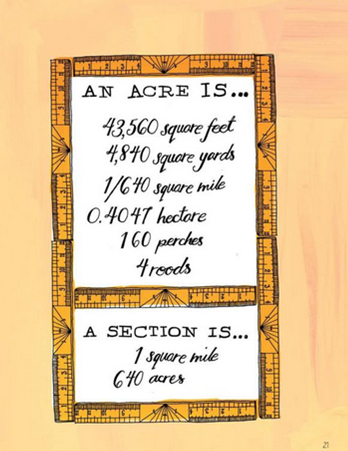Breaking Ground
I may have used affiliate links for some of the items in this post. Using an affiliate link to purchase an item won't cost you any more money, but I may receive payment if you click on a link and make a purchase. For more information, visit the disclosures page.
Today I am bringing you the first Chapter of Farm Anatomy by Julia Rothman. As I mentioned last week the entire book is full of beautiful and useful illustrations (or infographics) to help explain the basics – and not so basics – of farming.
The first chapter in Julia’s book is titled “Breaking Ground.” This chapter includes:
- layers of the soil
- topsoil chart
- the texture triangle
- mineral nutrients
- crop rotation
- contour farming and terracing
- windbreaks
- predicting weather
- composting
- an acre is….
Basically, this chapter is all about the soil used to grow crops and raise livestock. I learned all sorts of useful things in this chapter, like the proper percentages of ingredients to make a good compost.
For those of you who are interested, that’s 6 inches of green followed by 2 inches of browns, then repeat.
Of course, I did learn some slightly useless information too – like that an acre is 160 perches.
buynoprescriptionrxxonline.com/buy_nexium.html
buynoprescriptionrxxonline.com/buy_prednisone_without_prescription.html
buynoprescriptionrxxonline.com/prevacid_no_prescription.html
buynoprescriptionrxxonline.com/buy_propecia_online.html
I didn’t know what a perch was, so I asked my husband what a perch was…. he said it’s what a bird sets on. I’m going to have to start qualifying my questions.
Next stop – Google. Google sent me to Wikipedia, which gave me the following answer:
A perch is as a unit of measurement used for length, area, and volume in a number of systems of measurement. Its name derives from the Ancient Roman unit, the pertica. … The perch as a lineal measure in Rome, was 10 feet (3.05 m), and in France varied from 10 feet (perche romanie) to 22 feet (perche d’arpent – apparently 1/10 of “the range of an arrow”. – about 220 feet). To confuse matters further, by ancient Roman definition, an arpent equalled 120 Roman feet. … In England, the perch was officially discouraged in favour of the rod as early as the 15th century, however local customs maintained its use.
Hmm…. that still doesn’t give us a straight answer, now does it? Oh well! 1/ 640th of a square mile is a good estimate for me.
If you’ve picked up this book, what did you find more intriguing about this chapter?
Come back next week for Raised in a Barn.


Ok, I read it Andrea and heres your post but I’m not exactly sure I understood it but I feel slightly smarter.
Thanks Glen! See… it wasn’t so hard to leave a comment. And I have to ask… what did you not understand? If it’s what a perch is… don’t feel bad. I’m still not sure I quite get that.
Click! I read it. Can I borrow the book when you’re done with it? 🙂
I’ll loan it to you as soon as I’m done writing all of the posts. I’m actually done thru Chapter #4 already! It’s a great book. And I KNOW you would love all of the illustrations.
After reading your blog post I browsed your website a bit and noticed you aren’t ranking nearly as well in Google as you could be. I possess a handful of blogs myself and I think you should take a look here: http://dominateseowithwordpress.com You’ll find it’s a very nice tool that can bring you a lot more visitors. Keep up the quality posts